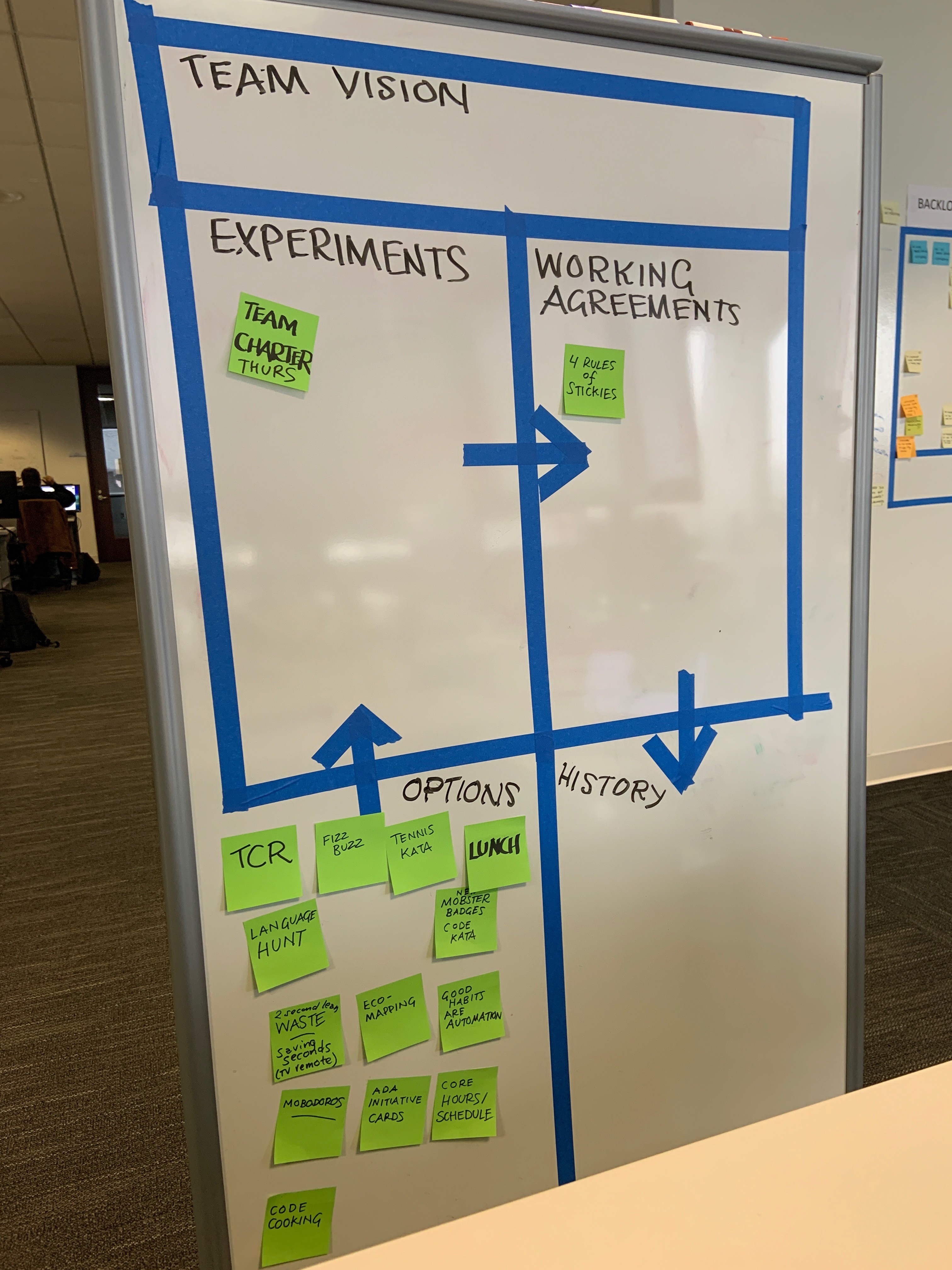In a previous blog post, I talked about some of the most important insights of awesome team learning.
They were:
- Nobody Needs to Be a Better Person
- Learning Must Be Tiny
- Working Agreements Are The Ever-Evolving Rules of Play
- Awesome Games Are Awesome Collaborations
Let’s drill down into one possible way of implementing all of these insights through what I call the Continuous Improvement Canvas or team improvement board.
But First - A Brief Note on Chartering
Chartering is the bedrock of successful teams. For more on chartering, I encourage you to check out the Industrial Logic cheat sheet on chartering.
Just like with “micro-retros”, it’s entirely permissible to do “micro-chartering”. Some of my best teams were kicked off with nothing but the agreed upon Vision that we all simply wanted to seek greatness together.
Really. That was it.
The rest of our charter came later over the days, weeks, and months of working together.
Though I used the phrase working agreements in my blog post, and habitually do so as a coach, if you look at the previously mentioned cheat sheet, you’ll see I’m referring to the umbrella concept of Community Agreements, a term that covers several categories of team alignment (in the cheatsheet they are Working Agreements, Designed Alliances, and Values/Principles).
In this way, the Continuous Improvement Canvas is a way of including “continuous chartering” as part of your retrospective cycle.
What Is Team Learning Anyway?
When we’re talking about team learning, we’re not necessarily talking about learning new technologies or particular technical practices. What we’re definitely talking about is how to weave our separate excellences together - in essence, we’re learning how to move and learn as a team. This embraces the technical learning needs that the team has but isn’t limited to it.
Team learning at its core is about the continual flow of working agreements through our team culture.
The Quadrants of Learning

I like to have an information radiator displaying the different states of working agreements that we are continually testing, implementing, and retiring.
In pre- and post-pandemic times, this is ideally a physical board if you’re co-located. During the pandemic and for remote/distributed teams, pick your favorite digital service and create the board there. For sure, screen share it on Zoom whenever you run your retrospectives, but make sure anyone can log in and see it at any time.
The quadrants on the canvas are the buckets that help us organize the insights we collect from our retrospectives. For many teams, retrospectives are usually held at the end of every iteration or every 1-2 weeks. The continuous improvement canvas really shines as you move it to daily, twice-daily, and in the best of all worlds, when you hold micro-retros after every ~25 minute work session. That’s when the need to manage all that learning demands a tool like the canvas.
The less often you run retrospectives, the more dust the canvas accumulates, and the less utility it has.
The Canvas Header: Team Vision
A brief summary of what you’ve decided is your vision/mission/objectives so far (see Chartering cheatsheet) is an excellent thing to have in plain view. Making it easy to point at in retrospectives keeps your team focused on why you’re here in the first place.
Quadrant One: Options
If we’re running a lot of retros, if we’re continually asking the question:
“What did we notice about that last work session? About our tools, interactions, process, environment? What’s one improvement we could make?”
…we’re going to have a lot of ideas for improvements and experiments. We can’t do them all at once. We need a bucket to hold these ideas that we’re not quite ready for.
Some of these improvements I call house cleaning: small, easy to implement changes in how we work. These can literally be as simple as new cleaning and organization habits - wipe down dry erase boards at the end of a day, recycle any obsolete sticky notes, etc. But they aren’t limited to this. House cleaning consists of things we can just do and not worry about any learning loop around them. We know they’ll work. They can either skip to the working agreement quadrant or just be something we take care of now without needing a reminder.
However, other improvement ideas are in need of an experimental phase.
Quadrant Two: Experiments
Experiment Limits
To really do an experiment right, you need to isolate it as much as possible from other experiments in order to judge its impact on your team.
This usually means only one experiment is in flight at any one time.
It can also mean you parallel experiments that shouldn’t impact each other. One experiment might be a change to your retrospective cadence (from weekly to daily, for example), and another changes your keyboard input set-up (throwback to the pre-pandemic days of colocated mob programming!) to accommodate the mix of colemak, dvorak, and qwerty enthusiasts on your team. These seem pretty independent of each other and probably could be run in parallel without an issue.
An experiment doesn’t need to be overly scientific or have an upfront hypothesis. It’s enough if you just say, “Let’s see what happens if we do X.” This, in complex systems, is called a probe. Sometimes to even learn how to evaluate something, you first need to try it out.
Experiments can also have a precise set of acceptance criteria. “If this hypothetical documentation practice cuts our time spent dealing with X problems in half, it is worth the extra book-keeping burden.”
There’s no one right way to run an experiment. You could almost say the only wrong experiment is one you never try. Make them small, easy, quick, and do them often. This is the heart of the Modern Agile principle Experiment and Learn Rapidly.
Time Limits for Science
You should decide beforehand how long you want to spend on the experiment - 3 days, 1 week, 2 weeks, whatever makes sense, and write this date on the index card or sticky representing the experiment. When this date arrives, it’s time to decide where to move the new habit/idea: the working agreement quadrant or the trash. Did it help? Did it hinder? Do you need more time to experiment?
Time Limits for Wanna-bes
Listen, it happens to the best of us. You thought you cared, but you really don’t. Time passes, the date pops up, and you realize as a team that you haven’t even touched the experiment, or maybe only tried it once. These are results too! It can shake the dust off of your complacency and focus you in on whether this is the time for this experiment, if ever.
Teams I coach will usually discuss this and decide to either try again with a new (and final!) deadline, retire it back to the Options quadrant till it’s relevant, or junk it as something you thought mattered but actually didn’t.
Any experiment that is successful, and has improved life for the team, moves into Quadrant Three and becomes a real working agreement.
Quadrant Three: Working Agreements
This quadrant is to hold reminders for new habits of teamwork that you are working towards doing fluently. You need these displayed because, under stress, they are easy to forget about.
It’s best to use the “no more than 5-7” guideline for how many working agreements you have at any one time. Review this quadrant often to see if an old agreement has long since become an ingrained habit, and a reminder is no longer needed. This is usually enough to keep this list from getting too crowded.
Another reason to move a working agreement on to the next quadrant is that it simply doesn’t apply anymore - it has become obsolete.
Make these reviews part of your retrospective cycle.
Quadrant Four: History
Any old working agreements are moved into your team history. This record of team learning can be a great tool for large intervals in retrospectives - when running a look back at a 6-month or 1-year interval or at the end of a project.
It can also be profoundly useful for storytelling to other teams how your team got so good at delivering working software and satisfying customer needs. Why keep this knowledge to yourself? These stickies can be the meat of lightning talks or other presentations to come.
How Will You Do It?
This canvas is just one approach for juggling the needs of options, experiments, agreements, history, goals, and whatever else the team needs to align around. What are the unique pressures of your team environment? What new categories are needed? Which are irrelevant? What tools and processes would you use to achieve this remotely?
These are all questions you need to answer yourself - but don’t forget to share your insights with the rest of us. We all get there together, and the more of us seeking excellence, the more it will be possible to achieve and sustain it.




